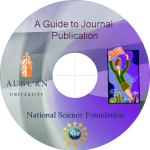

What is a Journal Paper?
A journal paper is a comprehensive and stand alone write-up of significant findings that contribute to the respective field. Journal papers range in length and scope, however, they must provide a clear contribution to the body of knowledge. Journal papers are considered "archival literature." That means, they are the permanent record of the research and are in the public domain.
In the past, journals were hard copy (paper) only, however, currently journals appear in hard copy and soft copy (and sometimes only soft copy). Journal papers are abstracted to online data bases by author, title, keyword, references, etc. Different journals are abstracted differently and a few journals (new or obscure) may not be abstracted at all. Journals can be published by professional publishers or by the organizations which sponsor the journal. Journals are not magazines. They do not contain advertisements normally, they are rarely in color and they do not contain materials other than the journal papers themselves (with table of contents and related administrative materials).
Nearly all journal papers undergo an extensive peer review process to ensure the quality of the work. This CD ROM discusses attributes of a journal paper in detail.
A conference proceeding paper is usually a 'short-version' of a journal paper with preliminary or incomplete research. The literature review of a conference paper is normally very brief and conclusions may be speculative. Conference papers should not be viewed, in most fields, as a substitute for a journal paper. Even if you publish research in progress in conference proceedings, you must still plan to produce a journal paper when the research is complete. Conferences are very diverse in selectively - some conferences have acceptance rates (through peer review) lower than that of many journals while others basically take all comers. Conferences proceedings vary dramatically in the availability of their papers. Some are quite obscure so that it is very difficult for a reader to locate and obtain papers from these conferences. Others are abstracted just as journals are. If this aspect of a conference proceedings is important to you, check if and where the proceedings has been abstracted in the past. Finally, do not think that there is a formula for promotion and tenure that equivocates journal papers and conference papers (such as four conference papers equal one journal paper). Journal papers and conference proceedings papers are fundamentally different - they have different missions and audiences and should always be viewed as such.
A trade journal paper is a paper that appears in a magazine type technical publication, such as produced by most technical societies. These are short articles that are easily read, often with color photos or diagrams. Few or no references are given and the technical development is minimal. These are not peer reviewed usually - an editor reviews the content.
An edited book chapter is a paper, usually on the long side, that appears in an edited monograph. Normally chapters will be invited or solicited by the editor(s) of the volume. The editor will already have the volume title, aim and scope defined. Chapters may be solicited on specific topics (to fill a need for a certain chapter) or may be solicited broadly within the scope of the volume's title. Chapters are similar to journal papers in format (though there may be no abstract) but are generally broader and may contain no new research. They might or might not be peer reviewed, however if reviewed, the reviewing process is focused on improving the chapter, not accepting or rejecting it. By the time the review occurs, the chapter is usually tacitly accepted.
A non refereed paper is a paper which is published (in print or online) but has not gone through the review process. These include some conference proceedings, trade journal papers (see above), and technical reports. They range from very short to extremely long and serve a variety of purposes with a diversity of audiences.
